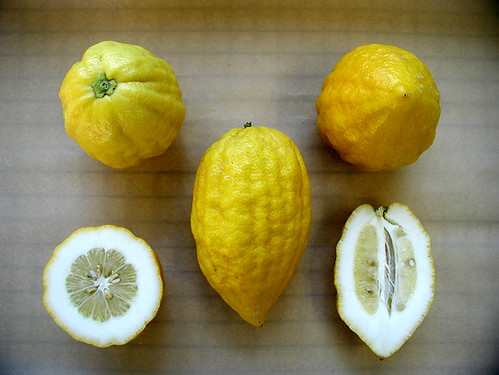a scent like no other
Modern naturalists assume the north of India to be its native home; but it passed to the countries of the Mediterranean from Media or Persia ; hence the name of the tree, "Citrus medica," and of the fruit, "Malum medica," or "Malum Persica".
It is therefore possible that the Jews brought the tree with them from Babylonia to Eretz Yisrael on their return from the Babylonian Captivity.
jews regard this fragrant fruit so highly — and in fact, are required to have one as part of the four species needed in order to fulfill the commandment for this holiday — that they will pay hundreds of dollars [literally] for the one perfect etrog that meets all the specifications of jewish law. there are even markets catered just to the selling and buying of this citron in israel & other big metropoli such as new york city.
for centuries, jews have had fashioned ornate and extremely detailed silver etrog containers for this fruit with plush linings so that no damage will occur throughout its handling.
an interesting note is that one should not smell the fruit until the correct time of the harvest festival and that the remnant stamen end, called the pitom, must remain intact or the fruit is not regarded as kosher for the fulfillment of the commandment. many etrogim have their pitom ends grown inside and are therefore more highly valued.
from jewishfoods.org [again]:
A superior Esrog is of medium size, its bright yellow surface is furrowed and covered with Blitos, bumps (a feature which distinguishes it from the ordinary lemon).
A Kosher Esrog for Sukkot:
- Consult your Rabbi about questions.
- Esrog must be shaped "like a tower"--its bottom larger than its top.
- Pitom, the flowered blossom at the tip of the fruit, and Uketz, the stem which is sunk into the broad base, must be examined carefully to make sure that both are present and intact.
- If the Pitom falls off or is broken during Sukkot, a rabbi should be consulted. To avoid this problem, many people prefer to use Esrogim which grow without Pitoms.
- The Pitom should be directly in line above the Uketz
for more about malum medica, try here, here or here which details the picking of the fruit in southern italy [of all places].
for some beautiful photos of etrogim [pl] look at this slideshow.
here is a recipe for it and information about the other things people do with the fruit when the holiday ends.
there is even a citron liqueur available.







5 comments:
Wow etrog liqueur! Who'd have thought!
I just bought A Treasury of Jewish Holiday Baking and there's a recipe for an etrog or lemon lime Sukkot cake I definitely want to try.
Hag same'ach
hi there,
yeah, i know. didn't know this liqueur even existed. wonder if it tastes as good as it sounds or is just more of a lemon flavoured kind of thing, like limoncello.
enjoy your books. i saw u got another one also. both are great. marcy has tons of always good recipes.
have fun in halifax.
Hi Burekaboy,
Well that's it for me...I'm going on a quest...can I find an etrog/lemon in Paris? If there is one to be found please believe me when I say I will find it! and since I have to go spice shopping tomorrow morning it will be a perfect occasion...
This is a most wonderful and inspirational blog indeed, what fun! tks,
Emily
hi emily — thank you for stopping by and your compliment!
yes, they are certainly available in paris. you have a big jewish population there and you can find them definitely in le marais or other jewish areas but not on the sabbath or jewish holidays as the [jewish] shops will be closed.
they are all different prices so look around. you do not need one so perfect -- tell them you want it for cooking.
you might also find them in a store which sells middle eastern fruit and/or spices of which you have hundreds in france. i would ask around. remember that "etrog" is the hebrew/jewish word and you may get strange looks if they are not familiar with the language.
you picked the right time to find one as the holiday has started in france already tonight. let me know how it goes and what you do with it! you may have more luck after sunday night finding one from a jewish shop. maybe call a store to see [usually une librairie would know].
emily,
ask for "un cedrat"
that will help more
Post a Comment